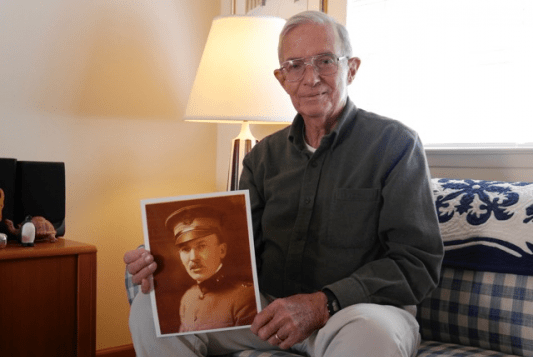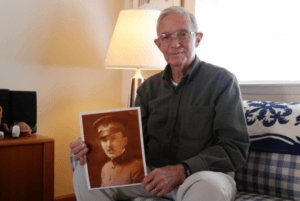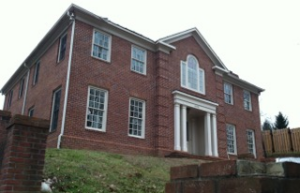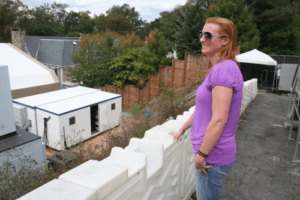
SONORA, Calif. — In a back room of L. Philip Reiss’ condominium, the retired chemical engineer has covered the walls and filled his drawers with mementos of a long life in science. In one corner, he’s hung keepsakes from years volunteering with a Boy Scout troop. In a small wooden cabinet, he keeps his grandfather’s collection of semi-precious stones. And in a drawer under his computer desk, he keeps baggies filled with vials of chemicals.
Crystals and powders filled the carefully marked samples. One vial contains a single, fat crystal labeled “Pydrin,” a keepsake from his years of developing pesticides at Shell Chemical Company. Another contains yellow sulfur crystals, resembling lemon-colored sugar.
Not every batch of chemicals from his laboratory is among the jumble of vials in his office. About 30 years ago, one of Reiss’ colleagues cooked up a small sample of an arsenic-based compound called lewisite, a combination of arsenic trichloride and acetylene.
This wasn’t just any compound — it was an extremely toxic chemical weapon agent dating from World War I. Nicknamed “the dew of death,” it caused pustules on the skin and severe respiratory damage, but was never used on the battlefield. After the armistice, sensational news reports described it as so lethal that tiny amounts could wipe out entire cities. “It was nasty stuff,” Reiss said to me. It was not the kind of thing you wanted around the house. When a former co-worker told him that he kept a sample from the batch, Reiss told him, “Don, get rid of it.”
Giving Reiss’ lab the task of making lewisite was a collision of past and present. During World War I, lewisite took its name from a chemist named Winford Lee Lewis, who turned a laboratory experiment gone wrong into a lethal weapon. Lewis was not just any chemist. He was Reiss’ grandfather and namesake; the initial ‘L’ of Reiss’ name stands for Lewis.
“I’m walking in the shadow of my grandfather,” Reiss mused, recalling how he worked out of buildings in Colorado where lewisite was manufactured by the ton, and his lab was later tasked with making a lewisite batch. “I knew the basic things, and I knew the war gases, and I had seen my grandmother’s scrapbooks — even as a young kid we liked to go through those. But not in the detail of worrying about it and understanding it and how it was made… It was one of those shots in the dark that got thrown away. That’s the way the world of chemistry can be.”
*
At 79, Reiss is an exuberant evangelist for chemistry. Tall and lanky with a shock of silver hair, he bubbles with an enthusiasm that he tries to impart to students in local schools where he volunteers as a science classroom aide. He erupts in chuckles when he tells me that the students call him “Mr. Science Dude.”
In December, I traveled to meet Reiss, whose name I had run across in a 2005 book about lewisite. I was working on a book of my own about the U.S. Chemical Warfare Service, and I wanted to talk to Reiss about his grandfather and his legacy, and look through family papers.
Over the last two years, I had contacted many other descendants of chemical warriors known as “technical men” — the chemists and engineers who had been wartime founders of the Chemical Warfare Service. I had tracked down the granddaughter and great-granddaughter of the man who had first sounded the alarm about how America’s lack of preparation for chemical warfare. I had talked with grandchildren of General William L. Sibert, who took control of the service in 1918. The granddaughter of a chemist who helped develop the first gas mask had opened her records to me. The granddaughter of a gas service chaplain sent me his war diaries to copy.
Not everyone I contacted welcomed my overture. The deep stigma against chemical weapons made some cautious. One woman wrote to me that “chemical warfare being a part of my own family history makes me cringe and want to atone for the destruction.” Others were wary of my intentions, or were simply concerned whether I was prepared to be fair and thorough in my investigation.
Among all of these men and women with family histories enmeshed in chemical warfare, Reiss was unique. Not only was he a chemical engineer himself, he had also lived through seismic shifts in public opinions of chemistry.
During his career, Rachel Carson’s book “Silent Spring” had fundamentally altered how the country regarded chemicals and the environment, resulting in tectonic regulatory changes for food, clean water and clean air. He was certainly the only relative of wartime chemists who had been a part of making the very weapon his ancestor created.
Reiss had already assisted the author of book where I had found his name; he pledged to help me as well in any way he could. He was concerned, though, with how his grandfather would come across. Chemical weapons remain so abhorred that he worried that his grandfather’s role in creating this weapons would overshadow his playful character, his other contributions to science, and his complex views about warfare and the weapons he had created.
“You say ‘chemicals,’ and adults who are not into the sciences are just as scared as kids are, that they’re going to blow something up or poison them. Blowing up and poisoning in chemistry all go together. Understanding of war gases and chemical warfare by the average American — if there’s one in 100 that understands it, I’d fall over backwards in amazement,” he told me.
*
Reiss lives in Sonora, California, in the foothills of the Sierra Nevada Mountains, about three hours south of the frontier town where his grandfather grew up. On my drive from Sacramento, the road wound through California gold rush towns with names like Angel’s Camp, Tuttletown and Squabbletown. Bald rocks jutted up along the roadsides — remnants of the gold rush, when prospectors used high-pressure water jets to blast away topsoil in the search for gold.
Reiss came out to meet me when I pulled my rental car into the spot in front of his condominium, wearing a blue windbreaker from his alma mater, the University of Delaware. We sat down at his kitchen table, where Reiss spread papers across the gingham tablecloth.
Reiss had only a few memories of his grandfather, “the Colonel,” as the family called him. When Reiss was a boy, Lewis was old and infirm, beset with tremors from Parkinson’s Disease. Reiss remembered being slightly afraid of him. Then he told me his one clear recollection of his grandfather, an anecdote that had nothing to do with chemistry but illustrated Lewis’ wit and sly sense of humor, he said.
“Cheerios had just come out, the little doughnut shape,” Reiss told me. “He said, ‘Philip, these are seeds for a doughnut tree. If you plant this, you’ll have a doughnut tree.'”
As he told it, Reiss laughed at the joke, and so did I. Much of my research has involved poring over bureaucratic files in the National Archives and universities and military instillations, squinting at records on wrinkled onion paper that yield few clues to the character of the scientist and soldiers who typed and dictated them. In a way, I had come to Sonora to hear stories like the one about the doughnut tree. Anything that provided hints to what this man was like.
Chemical warfare is such a fraught subject, so steeped in moral opprobrium, that it warps discussion of it as a historical subject. It’s easy to forget that flesh-and-blood scientists were behind the effort, people with families and children and grandchildren. It’s become almost impossible to talk about it stripped of its moral dimensions.
At the same time, I’ve wondered why the scientists so rarely addressed the implications of their wartime work. Perhaps there is a rich body of private writings that have been lost to history. More likely, though, the technical men like Lewis simply didn’t have the time or luxury of moralizing while enmeshed in the investigations that occupied their every moment during the war.
“He was not a crazy chemist trying to kill the world; he was a patriotic American doing what he thought was best for the time,” Reiss told me.
*
Lewis’ claim to fame was almost accidental. A chemistry professor at Northwestern University, he came to Washington in fall of 1917 to discuss a commission with the Sanitary Corps, which probably would have forced him to go overseas with departing troops. Instead, he chose to work for the Ordnance Department of the Army, working on war gases.
He ended up working out of a lab at Catholic University, where a professor told him about the thesis of a chemistry doctoral student. The young priest had done an experiment that produced a foul-smelling black tar. When he sniffed it, the compound immediately sickened him and sent him to the hospital for several days.
Told of this failed experiment, Lewis found the thesis, recreated the reaction between arsenic trichloride and acetylene, and figured out how to purify the compound into a liquid using another chemical as a catalyst.
The result smelled like geraniums, and was so lethal that the U.S. Army ordered it manufactured on a mass scale for deployment against the Germans in spring of 1919. After the war, the hitherto unknown chemist became known as the inventor of lewisite, “Our Super-Poison Gas,” as the New York Times put it.
After the Armistice, international opinion turned sharply against chemical warfare. With the war over, Lewis was free to talk about the backlash in articles and after-dinner speeches, for which he was renowned. He was regularly called upon to deliver such addresses, as his work on lewisite had turned him into both a reviled and revered figure, giving him notoriety that he made light of in his speeches. “I have been cussed and discussed by my colleagues and cajoled and flattered and upbraided generally,” he said in a 1922 speech.
He took a commonly held position that chemical weapons weren’t inherently less humane than, say, high explosive shells or bayonets or hollow bullets made to shred flesh more efficiently. Other veterans of this period took the same position, including James Bryant Conant, who also worked on lewisite. Conant went on to become president of Harvard University, and later was a key figure in the Manhattan Project.
Referring to an international disarmament conference working to ban chemical weapons at the time, Lew is said: “In the report of one of the committee it was stated that chemical warfare is a ‘cruel, unfair, and improper use of science.’ The answer to this statement is: ‘So is all warfare.'”
I asked Reiss if people like his grandfather truly believed that, or if was simply a political expedient defense of a new type of warfare that they had helped to create. “Oh boy,” he said, reflecting on it for a moment. “I think they probably believed it, reading the way my grandfather expressed some of those things. In this day and age it’s very hard for a person to believe that.”
“How do you justify the chemical warfare service?” he went on. “I think the best way is, ‘if the other guy’s got it, I’ve got to have it.’ It’s just like the atom bomb — nobody who’s in their right mind is ever going to use it — there may be some people that aren’t in their right mind that get ahold of it and might use it — but nobody with any particle of intelligence and feeling would think about using that again, because if they do, they’re going to get it right back in their face. And that’s the end of the world.”
*
At times, Reiss sounds nostalgic for chemistry’s early days, when scientists took great risks in pursuit of their arts, when they dipped their fingers into beakers and vials or sniffed the fumes. He’s in awe of the fact that it took only six months for the Army to scale up lewisite production from a jerry-rigged lab contraption to industrial manufacturing levels — a feat that would be impossible today.
But he’s also a pragmatist, and believes the world is better off with laws to prevent chemicals from getting into the water, the air, the food supply, as well as the battlefield. Reiss’ career, in a manner of speaking, straddles the fault line between the unregulated, wild west of chemistry that predated “Silent Spring” and the modern, more regulated, safer environment of chemistry today. “The world changed dramatically, and for the good,” he said.
In a way, his lab’s run of lewisite illustrates that. For years, Rocky Mountain Arsenal made lewisite and mustard gas by the ton; later, the Army leased those same buildings to Shell Chemical, where Reiss worked on manufacturing pesticides. The area was so toxic that migrating birds would alight on nearby lakes and immediately die, he told me. Chemicals leaked into the water, and there was arsenic in the soil and water around the arsenal.
In the tangle of litigation over pollution, both Shell and the federal government wanted to determine whether the arsenic was naturally occurring or a byproduct of lewisite production. The best way to do that was to make a batch of lewisite, break it down, and use the purified breakdown products as analytical standards to compare to the arsenic in the ground. By then, Reiss had moved from Rocky Mountain Arsenal to another Shell lab in California. When Shell asked for the lewisite sample, Reiss gave his grandfather’s paper to his colleague, who made about 50 or 60 grams in the same way that Lewis did in 1918. “I certainly didn’t open the lid to smell it,” Reiss said.
Reiss had left Shell Chemical by the time that investigation was finished, and told me he doesn’t know how or if that batch of lewisite contributed to the cleanup. In any case, after a $2.2 billion restoration and cleanup, the arsenal is a national wildlife refuge. A new visitor center opened there in 2011.
There’s still a bit of the chemical warrior in Reiss, who agrees with the notion of deterrence that ran through both the U.S. chemical weapons program and eventually, the nuclear program. But he has little interest in his grandfather being remembered as some kind of a doomsday scientist.
“My sense of him from my mother and my aunt and then getting into all his documentation is that he was a very honorable and very respected guy. And I think he was doing what he felt was his patriotic duty in volunteering to go help in any way,” Reiss said.
After two days, my visit was coming to an end. A storm was brewing over the Sierras, and I needed to leave before the snow came. I asked Reiss if he had any last words about his grandfather. He said he’d prefer that Lewis were remembered as the multi-faceted man that he was. A singer, a guitarist, and occasionally a poet. A doting parent and a spry conversationalist, full of quick-witted repartee. A father who on a cross-country trip back home to Illinois, warmed his infant daughter’s milk in the hot water from his Model T’s radiator, as he showed me in a photograph.
“I have an amazing admiration for him, and an amazing respect for him, and if I had to take somebody to lunch, he’d be the first guy I’d take,” Reiss said.
@TheoEmery
Theo Emery is researching the creation of the U.S. Chemical Warfare Service under his Alicia Patterson foundation grant.




